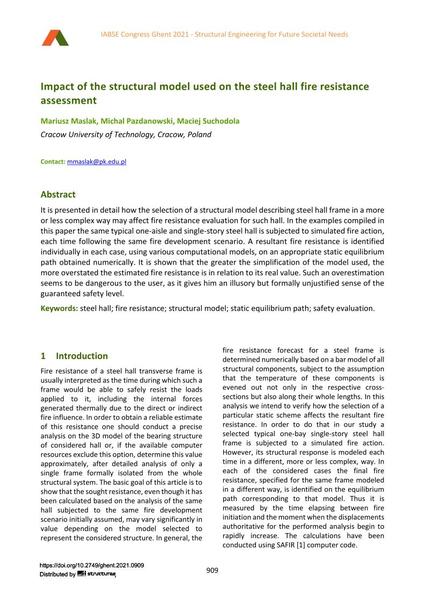Impact of the structural model used on the steel hall fire resistance assessment

|
|
|||||||||||
Bibliographic Details
| Author(s): |
Mariusz Maslak
(Cracow University of Technology, Cracow, Poland)
Michal Pazdanowski (Cracow University of Technology, Cracow, Poland) Maciej Suchodola (Cracow University of Technology, Cracow, Poland) |
||||
|---|---|---|---|---|---|
| Medium: | conference paper | ||||
| Language(s): | English | ||||
| Conference: | IABSE Congress: Structural Engineering for Future Societal Needs, Ghent, Belgium, 22-24 September 2021 | ||||
| Published in: | IABSE Congress Ghent 2021 | ||||
|
|||||
| Page(s): | 909-916 | ||||
| Total no. of pages: | 8 | ||||
| DOI: | 10.2749/ghent.2021.0909 | ||||
| Abstract: |
It is presented in detail how the selection of a structural model describing steel hall frame in a more or less complex way may affect fire resistance evaluation for such hall. In the examples compiled in this paper the same typical one-aisle and single-story steel hall is subjected to simulated fire action, each time following the same fire development scenario. A resultant fire resistance is identified individually in each case, using various computational models, on an appropriate static equilibrium path obtained numerically. It is shown that the greater the simplification of the model used, the more overstated the estimated fire resistance is in relation to its real value. Such an overestimation seems to be dangerous to the user, as it gives him an illusory but formally unjustified sense of the guaranteed safety level. |
||||
| Keywords: |
fire resistance safety evaluation steel hall structural model static equilibrium path
|
||||
| Copyright: | © 2021 International Association for Bridge and Structural Engineering (IABSE) | ||||
| License: | This creative work is copyrighted material and may not be used without explicit approval by the author and/or copyright owner. |
||||
